Preamble
I normally try to keep my travel pages short and sweet, but with this trip I simply found it impossible. There was so much to see, and so many things to photograph. I struggled with photo selection for the page, hoping to get it down to 100-150 photos, but after 9 months, I had only managed 250, and at this point, every photo removed hurts, and loses part of the story. So, sorry, you will have to slug through a very long page, if you want to see what happened to me in Egypt. Note that I have slightly rearranged some photos, to make a cleaner presentation, so it is not competely, but almost, in chronological order.
The exchange rate is €1 = £7.
On the way down to Egypt, I was talking to an older Nubian man (the Nubians live in the southern half of Egypt, and are looked down upon by the Arabs, who live mostly in the north) who had worked 10 months, 10 hours per day, 6 days per week, in the Egyptian Embassy in Berlin, and he had managed only to save €100. He was bringing 120kg of things for friends and family, and had to pay €300 for this. The Arab flight attendants would systematically ignore him, and he would have to ask two or three times for something as simple as a glass of water, and he wasn't being very demanding.
After an otherwise uneventful flight, we were picked up by a driver from the hotel. He was a bit of a joker and kept saying "Mr. Thomas, welcome", to Thomas, one of my two travel companions, the other being Wolfram. Cairo traffic creates as many lanes as there is room for in a given street, completely ignoring all marking. All cars had little dents. We arrived in Cairo, and checked into Hotel Luna, a nice affordable (£170 per night for all three of us) little, slightly run down hotel, but with friendly and helpful staff. There was basically one person at the front all the time, and one person helping out all over. The helper was great, and told us that he was an orphan, but was in training, and he was clearly very eager to improve his lot in life. Living and working in Egypt means for most people that you cannot afford to be ill, and you have to work constantly to keep up with expenses. If you are able to, you might save a little money for a vacation once a year, but lots of people can't pull this off. There is little outright poverty, but the ruling classes clearly belong to another universe compared to the man in the street. Even getting a job abroad does not necessarily guarantee anything, as the story of the Nubian man shows.
On our first full day there, we had breakfast, consisting of three dry buns, butter, jam, and tea, and then we visited the Egyptian Museum, £40, a large, chaotic place. There were artefacts everywhere, simply standing around, many unprotected. Parts of the museum were well organised, others were a shambles, more like a warehouse. The advertising for the museum was poor, and we were very surprised when we found out that the Tut Ankh Amun exhibition was there, gold mask, and both inside and outside golden sarcophagi, as well as a large amount of stunning jewellery. Unfortunately, you may not take photos in the museum, so we have no pictures from there, no artefacts, no mummies (£100 for us, £10 for Egyptians), no Tut Ankh Amun, which is a crying shame, because it was so spectacular.
We were meant to leave the camera outside, but this was an adventure on its own. There is a small shack next to the entrance, with a long lineup of tourists, and on this particular day, it was very busy. So busy in fact, that they ran out of numbers for cameras, so they started sending us into the museum with our cameras, with stern warnings not to use them. There were guards everywhere, so taking pictures on the sly was impossible, and the repercussions might have been severe, so I didn't try. Don't fool around in countries where you don't know the law.
After the museum, we made our way back through the traffic, which is very pushy and chaotic, but not actually aggressive, to find somewhere to eat. One place that was in both our tourist guides was Felfela, a really nice little restaurant with great food and hanging greenery from above.
On the way home, we were shanghaied by a guy claiming to be perfume supplier to Omar Sharif and other famous people, and he took us to his perfume store, talking, talking the whole time, putting various perfumes on us. Apparently Egyptian men often wear perfume, but none of us do, so after realising this, he let us go, but took us to Mustafa's travel agency next door, Happy Center Travel. This turned out to be a bit of luck, and Mustafa was able to book us for most of the rest of our trip, at reasonable prices, and only minor deviations from the promised service. He had lived in Canada for perhaps 10 years, had a German girlfriend, and wore a hockey jersey, not a mean feat in the Cairo heat. He booked us for a felucca ride up the Nile from Aswan to Edfu, pickup and tour of the temple, and drop-off in Luxor, as well as a separate, two-day tour of the western desert as we wanted to see parts of Egypt outside the Nile basin too. On the way back home, we got dragged into another perfume store by a guy who claimed to be the personal perfume supplier of Omar Sharif and other famous people, but managed to leave quicker this time, and swore we would not be such suckers again.
Back at the hotel, after quickly cleaning up, we met Mustafa again, who had meanwhile arranged for our tickets to be picked up at the train station, and went to a café to wait. Once the tickets arrived, we went together to the Townhouse Gallery, where we looked at some paintings and met a Danish and a German girl, artists-in-residence. Thomas and I wanted to buy a large and small painting, respectively, but in the end it never worked out. After the gallery, we went home, which was chaos. We had arrived in Ramadan, and no one eats until sunset, and then after stuffing themselves, the Cairo inhabitants walked around everywhere, and are simply outside, happy to be walking around.
The air in Cairo is very bad, and after a couple of days, I had a sore throat. I initially thought I was catching a cold due to the airconditioning in our room (I was sleeping directly underneath it), but I wasn't coughing or sneezing, and after a while the truth dawned on me. Sure enough, when we left it cleared up pretty quickly, and when we returned later, it came back again. I would not recommend planning extended stays in Cairo.
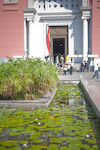
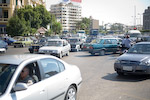
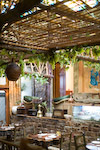
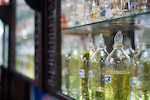
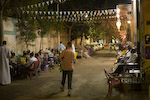
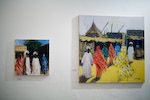
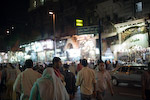
At the pyramids, we were told by our driver not to talk to anyone, not even police. Everyone wants a little baksheesh, and will do all kinds of little things to "earn" it, none of which we really wanted, things like offering to take our pictures, show us things, and whatever they could think of, all quite useless. There were swarms of people like this, which was a bit unpleasant, as you end up walking around the whole time saying "no, thank you, no". The camel rides were also not advised, as the riders would tell you £10, and then at the end of the ride, demanding £50 to make the camel kneel. Camels are very tall... If you want to go for a camel ride, do it elsewhere, and make sure that the kneeling is included in the price.
We started at the Great Pyramid of Cheops (Khufu), and the two successively smaller ones next to it, Chefren (Khafre), and Mykerinos (Menkaure). The Great Pyramid is simply astounding, and was built to standards more exacting than modern buildings. You couldn't fit a toothpick between two stones, and inside, you couldn't stick a business card in an undamaged crack. Unbelievable. We were expecting to be impressed, but this was beyond that. It is huge! I must have taken 100 shots around the pyramids, but culled it down a bit later. You can get into the Great Pyramid, but may not bring a camera. I used my cellphone to take a few photos inside, but when we exited again, found out that we could easily have bribed the guards, since they offered it. I wish they had asked before, and I would certainly have paid.
In front of the pyramids was the Sphinx, not in great shape. They seem to be fixing it up, and it looks like they may even be building a new outer layer for it. I am not sure if I agree with this, but perhaps it is necessary, since it is basically falling apart, turning into sand. Just in front of the Sphinx, Cairo starts again. I was a bit taken aback by how close the buildings were, and indeed, they had to build a fence around the whole area, which is essentially in Cairo, to stop the encroaching, not always legal, construction. For an Arab, there is lots of money to be made from tourists around the pyramids.
We then drove to the Saqqara, or stepped, pyramid, a much older, and crumbling, structure. Not as large, not as interesting, but worth seeing if you have the time.
At the end of the day, we walked around in the Ramadan chaos again, this time opting for a restaurant which looked decent, but was nearly empty, as it was just before sunset. This was a big mistake, but a good lesson in Egyptian food, because the food was so greasy, and of such a poor quality, that it was nearly inedible to us. No wonder that so many Egyptians are heavy or overweight, in spite of their relative poverty. We take so many things for granted, including the quality of our food, that it sometimes comes as quite a shock when we realise exactly how others eat. From that time on, we almost exclusively ate in tourist restaurants. So much for the romantic idea of living like the inhabitants.
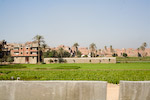
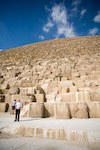
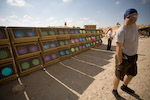
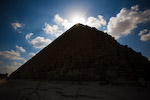
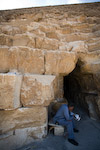
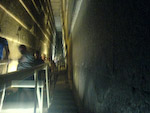
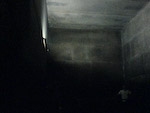
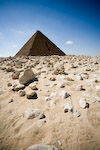
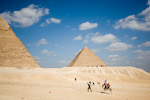
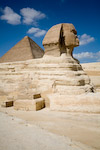
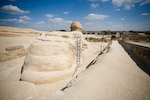
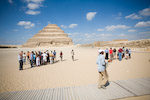
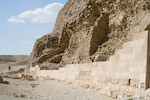
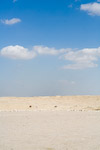
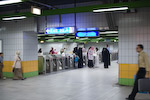
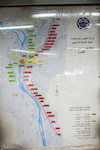
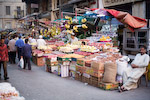
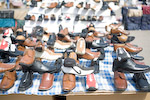
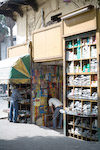
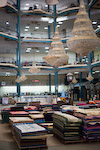
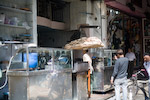
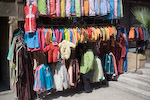
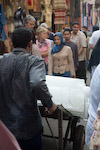
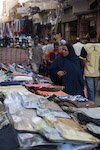
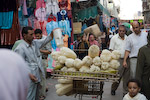
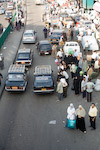
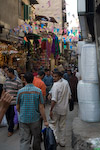
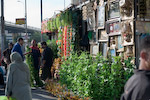
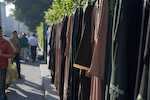
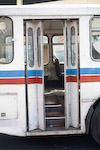
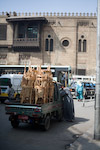
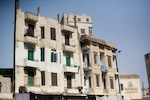
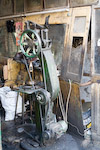
Anyway, it is a very beautiful and elaborate mosque, and an older custodian offered to take us around, naturally in exchange for some money, which was offered by us "for the upkeep of the mosque". Everyone was happy. He even took us up into one of the minarets, not quite to the top, but very nearly.
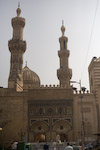
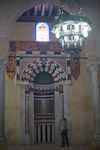
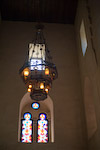
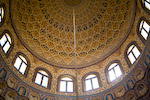
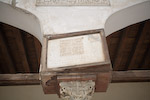
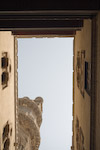
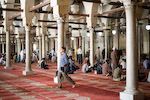
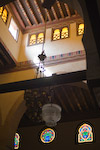
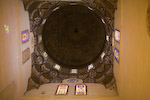
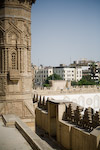
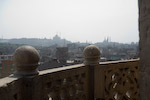
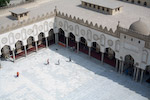
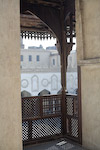
By the way, don't buy citrus juices or fruits on the street, it is often watered down, or injected with water in the case of the fruit, and our stomachs cannot handle the water.
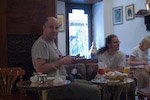
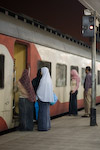
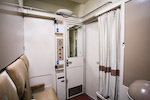
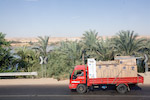
On one of our trips through the hotel, I bumped into the Austrian couple staying in the Agatha Christie suite, just as I was taking a photo of the door, and they invited me in to see the suite. Here you see the door, the view from the balcony, the balcony, the writing room, and the main room/bedroom. Lovely place, but much too expensive for us, at least on this trip.
We even strolled over to the New Cataract Hotel, in whose lobby we found garish shops and chandeliers, but also a nice spice store where Thomas bought some crystalised vanilla and other spices.
Sitting on the terrasse of the Old Cataract in the evening, sipping cold drinks after an exhausting day sightseeing in the sun is one of the greater pleasures in life. The hotel is expensive, but when you have a Thomas who can haggle the price down and then switch us into Nile-view rooms, it is still quite affordable for average Europeans. Well worth it.
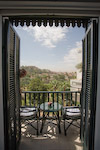
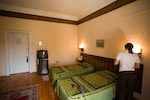
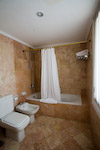
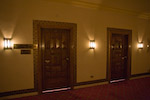
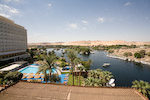
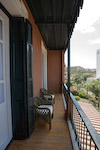
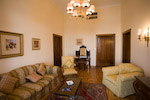
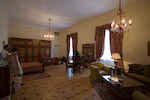
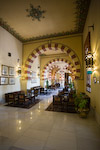
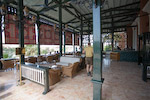
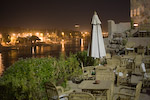
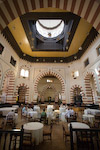
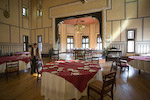
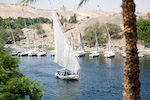
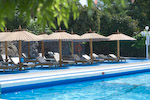
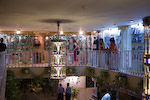
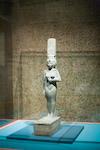
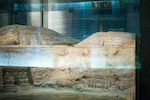
While walking around up on the hill looking for the restaurant, we came across three kids, two boys and a girl, aged about 10, who had caught a tiny crocodile, perhaps 30cm long. They showed it to us, but when it closed its eyes the boy holding it started squeezing and shaking it to get it to open them again, for our pleasure, so I quickly said "no, no" and gestured to stop, and gave them £1.
In fact, that was the only crocodile we saw on the trip, if I recall correctly. The Nile is rumoured to have lots of them, but I have no idea where they hang out. I suppose that there are enough people in Egypt along the Nile (almost all Egyptians live close to the Nile) that whenever one is spotted, it is quickly killed. Only in places like Europe do we have the luxury to allow such animals to continue to live, threatening us or competing for precious food.
After eating we walked back to Aswan and strolled around a bit. The people here are poorer than in the north, and even more pushy about selling you things. Again, most of the business men are Arabs. One particular guy followed us for half an hour, trying to get us to go on a boat ride, and he simply could not understand why we didn't want to take his boat, even after he had completely pissed us off. Later, an older and more experienced businessman (taxi driver) told us that the younger generation has no experience with tourists, and does not know how to do business and when to stop. It puts things a bit into perspective when you realise that this time of year there aren't many tourists, and if a particular salesman can't sell anything to you, he may not sell anything all day.
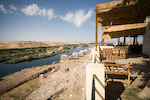
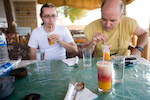
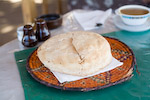

At the dock we met Karim, a young and ambitious Nubian with a small boat, who has since gone to study English and Spanish, to get an edge on his competition and further his career. He was very friendly and not pushy at all, and if you can find him, I highly recommend him. Philae Temple, one of the best preserved and more unique temples in the region, used to lie on the actual Philae Island (half submerged after the construction of the first dam), but when the Aswan Dam was built, it would have ended up completely under water, so a push was made to raise the money to move it to a nearby island with a similar shape. This island, in reality Agilika Island, underwent some changes to make it look more like the former Philae Island, now a rock under water, and then the temple was moved.
Among other attractions, there is a Nile-o-meter on the Island, two pieces of which are shown by Thomas (above) and Wolfram (below).
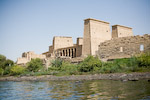
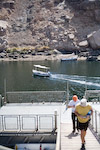
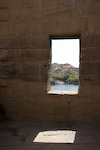
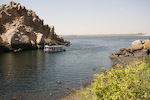
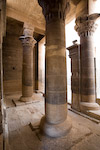
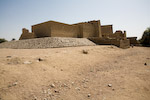
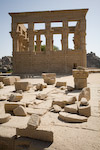
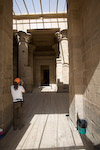
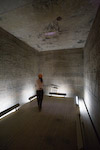
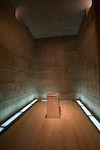
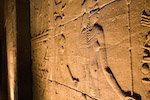
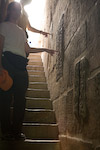
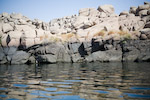
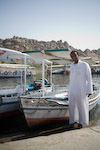
The café reminds me of a quote from "Angel Heart", where someone says "it is a free country", only to be answered by Mickey Rourke: "not for chickens, it ain't", except that here crocodiles were at risk, not chickens.
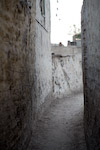
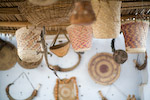
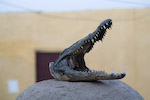
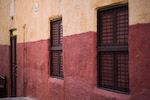
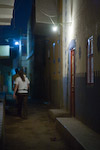
Along the dock there were tens and tens, perhaps around 50 or even more, tourist boats, huge garish things which one could use to see as little of the Nile as possible, since they sail quite fast at night. Horrid how some people spend their holidays, but then, some people eat McDonalds, so I guess it all fits together.
On the boat, we were served by a two-man crew, Captain Ruby, and a boy named Mahmoud, both very friendly, although a little slow to warm to us. I guess they see a lot of tourists and most aren't that friendly to them. We shared the boat with a really friendly Spanish couple, Christina and Jordi, and a much less friendly, and fairly inflexible and difficult Irish couple, who played favorites, made fun of people, and generally tried very hard to appear cool and flexible, and to make us seem inflexible, a real energy drain. We very quickly tried to have as little to do with each other as possible, with the poor Spanish couple somewhere in the middle.
As we set off, we came past the "Titanic", paddled by hand by two kids...
I woke up early on the last morning as we zig-zagged towards our destination, and was learning how to sail the Felucca while Mahmoud was playing captain and the captain was sleeping. It was a lot of fun, and the basics weren't that difficult, although I am sure there is a lot more to it than just the basics. Each night we could hear the mullahs in the distance, as well as the insects, and the stars were very clear and beautiful.
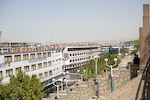
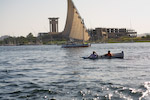
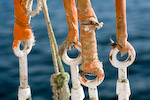
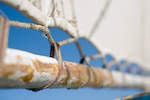
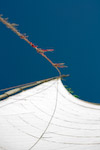
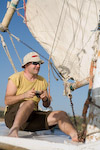
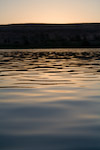

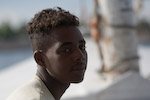
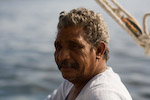
The two boys on the donkey were funny. They could have moved about 5 times as fast had they walked, but they seemed happy to ride. They initially had really disapproving-looking expressions, as can be seen on Thomas' site, but then I took a photo, and looked back at them with just as disapproving an expression. Then they cracked up and I took another photo.
One night just before sunset, we saw swallows catching flies, and so I present to you here: an unladen African Land Swallow (search for "the air-speed velocity of an unladen swallow") flying at its average air speed velocity! I took maybe 50 pictures to get one or two good ones; they turn so fast.
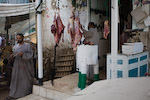
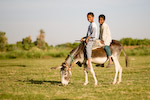
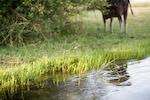
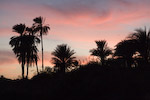
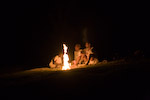
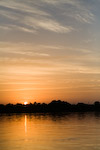
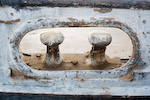
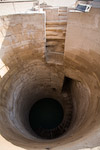
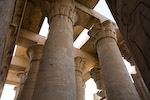
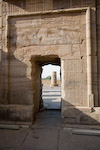

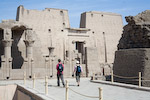
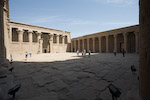
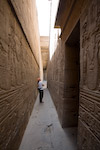
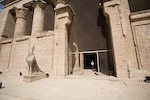
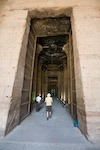
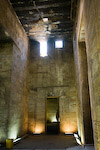
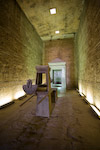
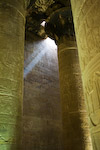
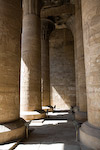
The longer you spend in Egypt, the less people hassle you. I am not sure exactly what it is which changes, but it does. After a week here, we could walk relatively unaccosted through places and watch with amusement how other tourists were singled out, but I still never really figured out what it was that changed, or how they could see it on us. I wasn't deliberately doing anything at all. It works less well for women, who either get hassled more, or get ignored completely. Egypt is a man's country, and you feel it all the time. I would not recommend that women travel in Egypt alone, or in groups without men, simply due to the unpleasant hassle-factor. It is somewhat safe, but not completely, so extra caution would be advised for those who try it anyway. No one is going to interfere much with an Egyptian man hassling or even grabbing alone-travelling women by the arm, except perhaps other tourists. Most Egyptian men were respectful enough, but it only takes one to ruin your day or trip...
In the evening, the hotel owner had put on a show which we decided to attend. There was a belly-dancer (who some thought was a man, posing, not a risk-free thing in Egypt), two young brats doing various tricks, and a Whirling Dervish, but a showtime version, not the real thing. Fun, but in hindsight I would rather have skipped it.
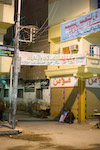
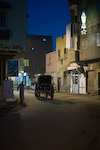
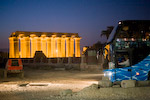
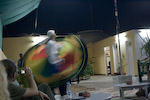
Hatshepsut Temple was essentially a facade only, at least to us. Stunning though it is, I couldn't help but feel a little cheated by the not inexpensive admission price. We did get a nice hike into the hills out of it, however, as well as some of the most scenic photos of the trip.
Hatshepsut was the fifth Pharaoh of the Eighteenth Dynasty of ancient Egypt, and interestingly, was a woman. Women didn't normally become Pharaohs, but she was unusually powerful. When her father, the Pharaoh Thutmoses I, died, she married her half-brother Thutmoses II, who then became Pharaoh. When he died in turn, Thutmoses II's son (not with Hatshepsut) was too young to rule, so Hatshepsut took over, her daughter assuming some of her former duties as queen. The story is quite complicated, but interesting, and can be seen here.
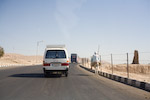
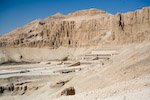
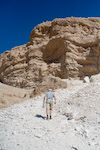
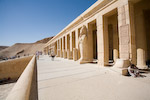
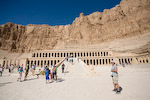
First we visited the tomb of Amenophis, but it was the tomb of Thutmoses III (photos 3 and 4) which was the best of the lot. With a standard ticket, you can visit three tombs only, but that was sufficient for us, especially since two of the three we had singled out were closed for renovation, and we had to choose others instead. Thutmoses III's tomb was stunning, however. The entrance was very high up, and then there was the obligatory first room, followed by a small but very deep room with a number of skeletons at the bottom (grave robbers inadvertently falling to their death, no doubt), and then two more rooms, one more stunning than the other. I was not able to take pictures inside the final room, it being guarded by a uniformed man with little humour, but I did get a photo of the penultimate room. The real tomb had the most unusual hieroglyphics I have ever seen, looking more like Tintin comic drawings than the typical drawings. Fascinating stuff, and I copied some of them by hand. Unlike Thomas who had read up on this, it was all comics with funny heads to me. Apparently there are scenes from the ancient Book of the Dead in here. We spent quite a long time in there, dripping with sweat by the time we exited. The rooms only allow a certain number of visitors per day, since the humidity which our bodies contain can damage some of the contents.
Our third and final tomb, Tawosret and Sethnakht, was also interesting, but to be honest, after Thutmoses III, it was less impressive than it might have been. I got some nice photos in here by asking Wolfram to watch for guards (the last three).
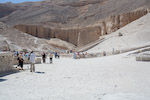
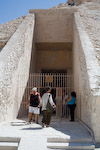
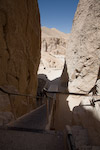
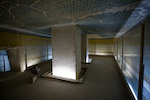
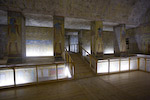
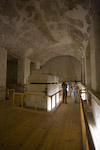
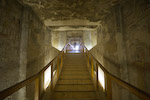
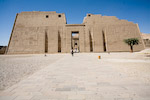
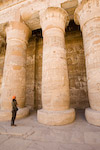
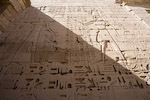
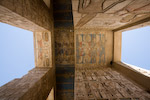
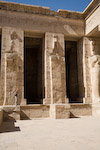
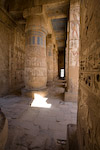
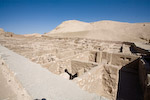

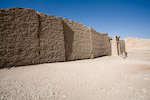
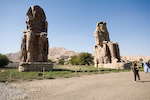
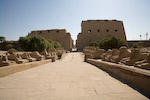
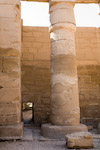
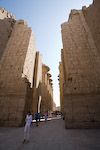
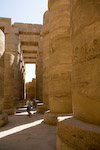
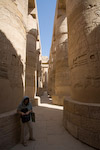
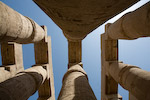
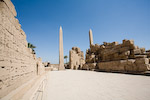
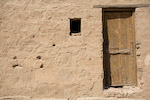
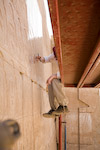
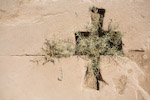
After that we went to the Luxor Museum, a real highlight, and the best museum so far. Well organised and labelled, and not too many things there, but enough to satisfy.
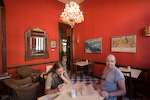



These kids just walked by, looking at us, but when I raised my camera slowly in their direction, smiling, they spontaneously posed, laughed, and then ran away chattering to each other. I hope that we, as tourists, are able to leave a good impression with some Egyptians. Many just see us as anonymous sources of money, and despise the way we show our flesh, which to them is vulgar. I would recommend at least wearing t-shirts and long shorts, but preferable would be long pants and a shirt with collar. Egyptians think of tourists who strut about in minimal garb, ignoring or ignorant of the disrespect, as money on legs.
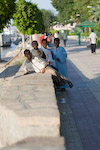
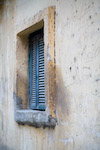
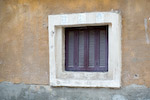
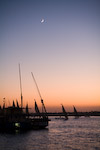
In one of these photos you can see Thomas climbing through a hole in Crystal Mountain, and in another, you see the worryingly broken-looking guard rails along one elevated stretch of desert highway. Mohammed claimed that the government built them this way to scare drivers into not falling asleep.
On the way back to civilisation, the bus had only seats for two of the three of us, so we took turns standing, gaining some respect from the Egyptians for not complaining about this. We do pay a lot more for the same ride, and complaining would surely have gained us a seat, but overall, it was well worth it to do it this way. One girl on the bus was not quite right in the head, and while people all around her tried desperately to sleep, she was just babbling on in a very loud voice. Her uncle tried to shush her, to no avail, and eventually it was just accepted that she was like this. I am sometimes pleasantly surprised at how Egyptians deal with problems, I must admit. In Germany she would have received a lot more heat. This is a hot bus ride of several hours, and she prevented anyone near her from sleeping, something few would have accepted here. She was actually relatively quiet and friendly on the one stop, but as soon as we got back on the bus, she started up again. Perhaps the close quarters agitated her.
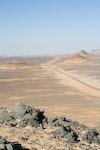
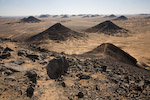
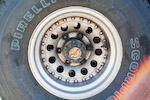
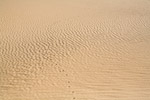

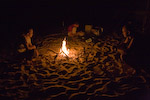
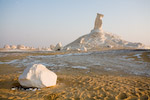
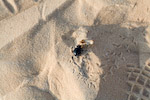
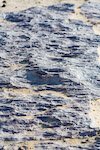
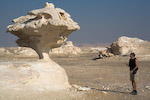
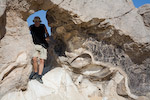
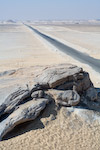
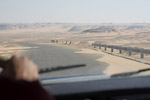
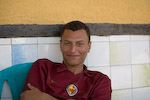
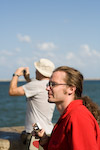
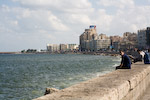
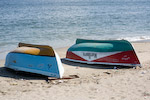
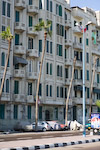
The menus in Egypt often had humorous typos, mistakes and creative naming, which made for entertaining reading when we were a bit tired. On this menu we find such items as "Latté snow-white", "Brawny with ice cream", "Profitrolle" (profit-roll?), and so on.
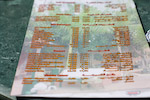
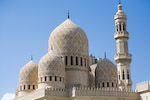
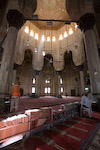

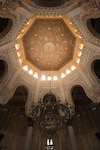
The fort was quite attractive, in perfect condition, and was built on the island of Pharos, on top of the ruins of the famous Lighthouse of Alexandria, starting point for story here.
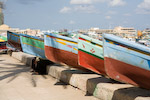
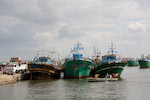
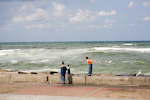
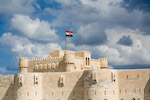
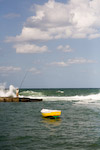
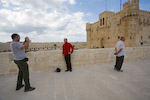
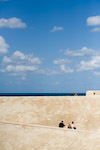
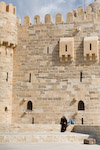
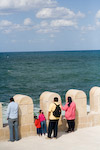
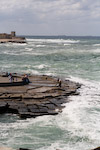
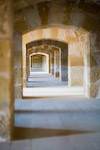
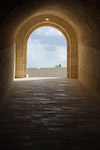
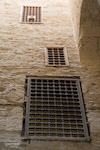
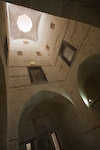
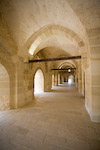
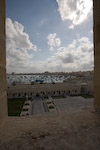
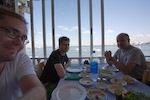
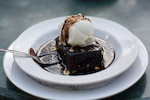
The library was organised in a classical fashion, with retoric at the very top, and English and Hebrew dictionaries at the very bottom...
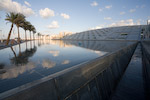
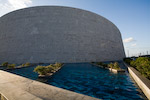
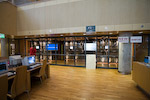
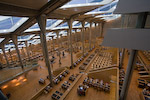
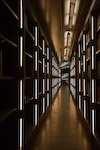
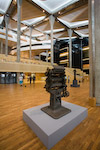
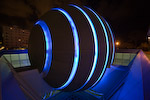
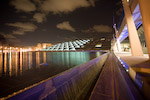
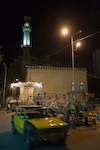
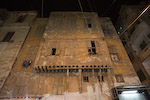
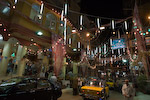
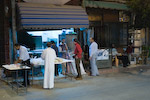
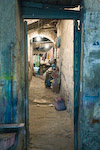
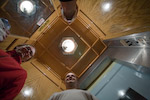
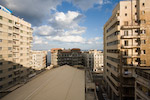
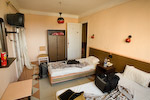
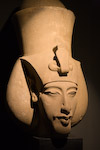
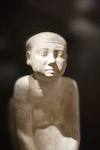
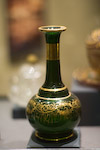

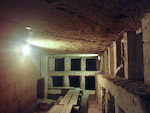

Later on, after eating a bite in the Jazzup, a very loud Salsa evening started up, and Thomas ran out, with Wolfram and I staying, a bit more curious. Some of the couples were actually quite good, and they seemed to be mostly local young Egyptian couples, spending an evening here. The music was continually turned high up and low down until it settled at a high, but non-painful level. One skinny guy with a very large girl was dancing between the tables, due to the acute lack of space on the dancefloor. It was quite strange to see such a Cuba scene in the middle of Cairo.
In the middle of the night, Thomas got a surprise visit from someone who tried walking straight into the room, claiming to be bringing replacement keys, and wanting a tip! Twenty minutes later, the phone rang in his room by someone wanting to confirm the spelling of his last name, and asking for our room numbers! All way after midnight. Unbelievable. Do not book at the Nile Hilton. We also saw some large, red cockroaches, and the building has apparently already been condemned.
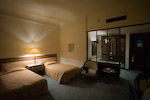
More or less our last stop on the trip was the Coptic Quarter, a tiny little neighbourhood of an ancient Christian sect, complete with their own popes and all. The Hanging Church was the nicest, although it was in the middle of restoration, and was fairly dusty. Afterwards we walked through the cemetary behind, and then visited the Saint Barbara church. The man taking care of it came over for the usual quick tour-n-baksheesh, but once he found out we were Germans, he proclaimed his love for German football, and showed us another room at the back, with interesting depictions of St. George killing the dragon. He admitted that St. George and the dragon had no specific place in their religion, but they liked the symbolism and imagery...
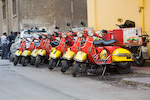
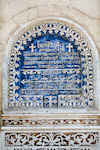
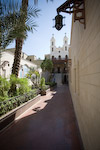
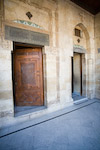
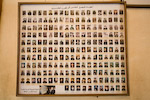
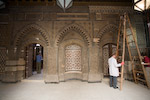
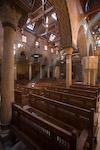
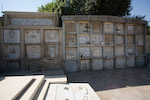
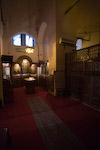
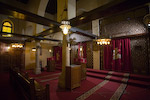
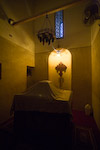
When we were done, we split up with Thomas, who wanted to see more, with Wolfram and I wanting to relax for the last time at the hotel. We met again on the rooftop Pyramid Bar, and watched the sun go down. After a failed sandwich attempt, we raided the desert buffet at the Ibis bar, where I got more stuffed than most locals probably get in their whole life. It is sometimes hard to reconcile the differences in standards of living between here and there, but it helps the conscience when you see how the upper classes of Egypt treat the lower classes. At least we treat them well, even if we are unashamedly rich in comparison. There just is no logic and no fairness to it all, let's leave it at that.

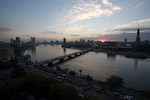
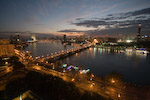
Egyptians are generally very friendly and polite, apart from the salesmen, and we were mostly treated very well, especially when they found out that we were German (well, I faked it...) and the Euro was by far the currency of preference. It used to be the American Dollar, but these days it is too volatile, and anyway, given American hostility to Arab nations, it is not surprising that the Arab nations turn their backs on the Americans in return.
A few tips and observations: one should always be very careful and specific about what was agreed on; misunderstandings are carefully nurtured in Egypt, and always cost more money. One should always carry something to drink and eat; it is not always easy to find something agreeable on short notice. In Egypt the big things are cheap (hotel, travel...) but the little things add up fast. Know and respect local customs and religion, if you expect to be treated with respect. Be polite and smile a lot. If a situation starts to look problematic, stay earnest and keep trying: there is always a solution, but rudeness or impatience can kill it. Stay firm though. There are animals everywhere, and even in the middle of cities, one can hear donkeys and roosters. There is garbage everywhere; people throw stuff on the ground with no care, even 1m from a proper garbage bin. Dust, dust, dust, pollution, everywhere. When taking a taxi, get a Peugeot 504 and avoid Fiats. Everyone wants to learn a little English. Walk on the sidewalks, you will have less resistance, since everyone walks in the streets. If you are a woman travelling alone or in a group without men, be alert and careful. Everything should be fine, but it is not as easy.
The Lonely Planet Guide which Thomas brought and the Rough Guide which I brought were indispensible. I preferred the larger overview and better background of information of the Rough Guide, but the Lonely Planet Guide was very good for individual attractions, so both had their raison d'être.
Footnote: Several of the images on this page were added to the Wikimedia Commons image library, and linked from the respective Wikipedia pages.